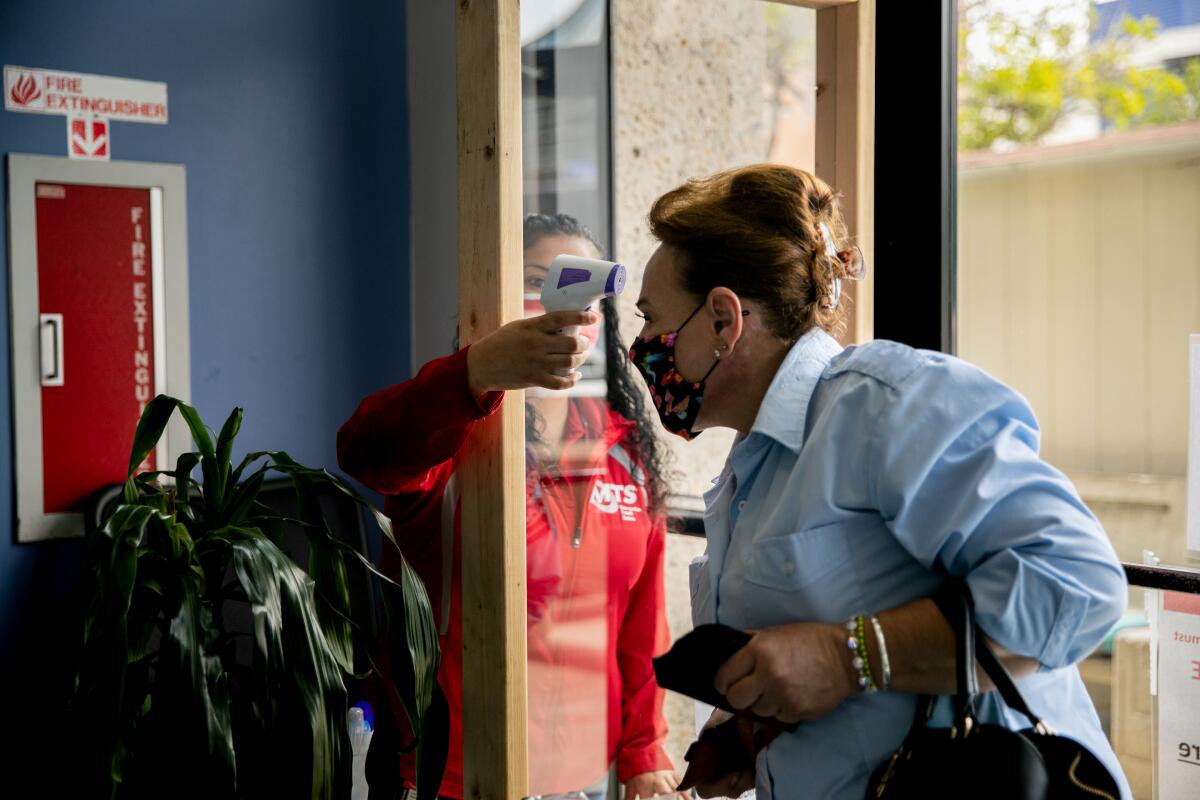Newsletter: Many Californians just got a major boost to their paid sick leave

- Share via
Good morning. I’m Rachel Schnalzer, the L.A. Times Business section’s audience engagement editor. This week, we’ll be discussing paid sick leave in California — specifically the 2021 COVID-19 Supplemental Paid Sick Leave law that went into effect Monday.
As my colleague Margot Roosevelt covered in depth, many workers in California were left with just three days of mandated paid sick leave after federal and state measures boosting COVID-19 leave ran out on Jan. 1.
“Since CDC guidance recommends that people who are exposed to COVID-19 quarantine for 14 days, this is not nearly enough,” said Katherine Wutchiett, an attorney with Legal Aid at Work. “We were seeing workers who were having to choose between going to work sick and endangering their customers and co-workers, or staying home but risking their jobs and their income.”
With the 2021 COVID-19 Supplemental Paid Sick Leave extension, which became law earlier this month, many qualifying employees now have access to 80 hours of paid time off for virus-related reasons.
Here’s what workers are now entitled to — and what employers are obligated to do in response to the law.
What are workers entitled to under the new paid sick leave rules in California?
Employees who cannot work or telework due to COVID-19-related reasons are entitled to paid sick leave if they work for an employer with more than 25 employees.
This includes — but is not limited to — workers who must quarantine due to COVID-19, those who are caring for a quarantining family member and those who cannot work or telework due to vaccine-related symptoms. “A strength of [the law] is that people are allowed to use this for a variety of reasons related to COVID-19,” Wutchiett said. For more information about who is eligible, visit this FAQ page.
The amount of paid leave varies based on an employee’s work schedule. Employees are entitled to 80 hours of COVID-19 Supplemental Paid Sick Leave if they are considered full time or if they worked or were scheduled to work an average of 40 hours per week at minimum in the two weeks before they take the leave. Active firefighters may be entitled to more.
Part-time employees who work variable hours are entitled to take 14 times the average number of hours they worked each day for the employer in the six months prior to their leave, provided they’ve worked for the employer for more than 14 days.
Newly hired part-time workers with variable hours are able to take the number of hours that they worked in the previous two weeks as part of 2021 COVID-19 Supplemental Paid Sick Leave.
Independent contractors are not entitled to 2021 COVID‑19 Supplemental Paid Sick Leave.
2021 COVID-19 Supplemental Paid Sick Leave covers the period of time between Jan. 1, 2021, through Sept. 30, 2021. This means that employees who took qualifying leave prior to the law taking effect Monday can request retroactive payment.
Employees are entitled to up to a maximum of $511 per day and $5,110 as a whole as part of the 2021 COVID-19 Supplemental Paid Sick Leave law.
What about workers of employers with under 25 employees?
Those who work for employers with under 25 employees are not entitled to 2021 COVID‑19 Supplemental Paid Sick Leave. “There’s no perfect solution for them,” Wutchiett says. However, “there’s a web of different protections that could be used to fill in those gaps.”
For example, workers who become exposed to COVID-19 may be able to get emergency temporary standard exclusion pay, Wutchiett says. “That’s really the only way somebody can get full pay.”
Otherwise, a worker may be able to get partial pay through programs such as state disability insurance and paid family leave, Wutchiett says, though they’re not ideal solutions. “Somebody has to decide, ‘Can I afford to lose 40% of my pay?’ And the answer for everybody isn’t necessarily yes.”
What if workers have trouble getting what they’re entitled to under the new paid sick leave law?
If an employer refuses to allow an eligible employee to take leave or refuses to pay them for the leave, the employee can file a claim or labor law violation report with the California Labor Commissioner’s Office. Employees can also contact the Labor Commissioner’s Office with any concerns about retaliation.
Workers can also access support from groups such as Legal Aid at Work, which offers free legal advice over the phone to low-wage workers. “We’ve gotten thousands of calls with people who have questions about their rights at work, and a lot of them have been related to COVID paid sick leave,” Wutchiett says.
Wutchiett also recommends that employees print out guidance issued by the Labor Commissioner’s Office to provide their employer. “ I always recommend sharing links, or printing out pages ... to educate them and put them on notice of what they’re required to do.”
What are employers obligated to do?
As of Monday, employers with more than 25 employees must provide 2021 COVID-19 Supplemental Paid Sick Leave, including retroactive payments for qualifying leave that was taken going back to Jan. 1.
Employers are obligated to make the leave available to covered employees immediately upon the employee’s oral or written request and must provide payment for the leave no later than the payday for the next regular payroll period after the employee took the leave.
Employers are required to make retroactive payments only if the employee makes an oral or written request to be paid for the leave. The retroactive payment must be made by the payday for the next full pay period after the worker requests payment, and the employer is obligated to indicate how many 2021 COVID-19 Supplemental Paid Sick leave hours are left to the employee on their itemized wage statement.
2021 COVID-19 Supplemental Paid Sick Leave must be made available in addition to regular paid sick leave, and employers are required to list it separately from regular paid sick leave on employees’ itemized pay stubs or in separate writing when wages are paid.
Employers are obligated to display this poster explaining information about the COVID-19 paid sick leave in a noticeable area of their workplace. It can also be sent electronically if the workplace is operating remotely.
How large a burden does this place on employers?
The new paid sick leave requirement is challenging for employers, said Benjamin Ebbink, a partner at Fisher Phillips.
One issue, Ebbink notes, is the relatively short period of time employers have had to come into compliance with the rules. “If you haven’t been subject to some type of paid sick leave like this, and you’re starting from zero and trying to come up to speed, it’s just not a lot of time.”
In addition, Ebbink points to the law’s retroactivity as a potential problem area for businesses. “Employers, going back in time, may or may not have done a very good job of documenting the reasons why the employee was out. And trying to reconstruct that to see whether it meets one of the qualified reasons is going to be a challenge.”
Though the federal government offers businesses a payroll tax credit for the leave, it may not cover all of the expense, Ebbink says.
“There’s a couple of caveats,” Ebbink says. For example, “the qualifying reasons where you’re caring for someone else, like caring for a family member, or caring for a child, because the schools are closed, those are capped at $200 a day,” rather than $511 a day.
Ebbink and other Fisher Phillips attorneys explain more in this alert.
Other stories you may find helpful
◆ Workers look to their bosses for mental health support — and many aren’t getting it. Roger Vincent covers the mental health challenges workers are facing during the pandemic.
◆ A Southern California man sought mental health treatment but couldn’t find a single suitable therapist within his insurer’s network. Columnist David Lazarus makes the case for doing away with insurance networks.
◆ Southern California home prices reached an all-time high last month, Andrew Khouri reports.
◆ L.A. will start accepting rent relief applications from landlords and tenants today. Khouri explains how to know if you qualify.
◆ What happens when ICE asks Google for your user information? Johana Bhuiyan describes the steps people must take to keep Google from providing their personal information to authorities who issue an administrative subpoena.
◆ Los Angeles now has a road map for 100% renewable energy. Sammy Roth reports on the findings of a first-of-its-kind study outlining a potential path forward.
◆ Bankruptcies are way down during the pandemic. Laurence Darmiento breaks down why.
◆ Who are the biggest tax cheats? The 1% — and here’s how they get away with it, from columnist Michael Hiltzik.
One more thing
COVID-19 turned Curative — which, prior to the pandemic, was a tiny start-up — into a virus testing giant. But can its results be trusted?
My colleagues Laurence Darmiento and Melody Petersen looked into the questions that have mounted about the test’s accuracy.
In January, the Food and Drug Administration cautioned that Curative’s COVID-19 tests might give patients false negatives, which could result in infected people spreading the illness to others. Not long after, administrators at a Colorado health system discovered that a string of positive COVID-19 results they received were incorrect.
The story of Curative “illuminates just how unprepared L.A. County, California and the nation were for the COVID-19 pandemic,” Darmiento and Petersen write. Read the full story here.
Have a question about work, business or finances during the COVID-19 pandemic, or tips for coping that you’d like to share? Send us an email at [email protected], and we may include it in a future newsletter.
Inside the business of entertainment
The Wide Shot brings you news, analysis and insights on everything from streaming wars to production — and what it all means for the future.
You may occasionally receive promotional content from the Los Angeles Times.




